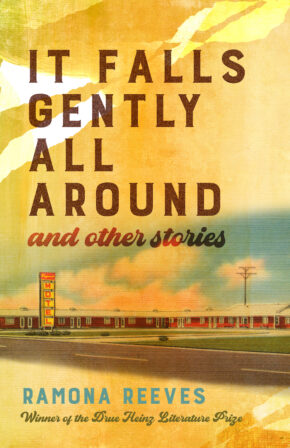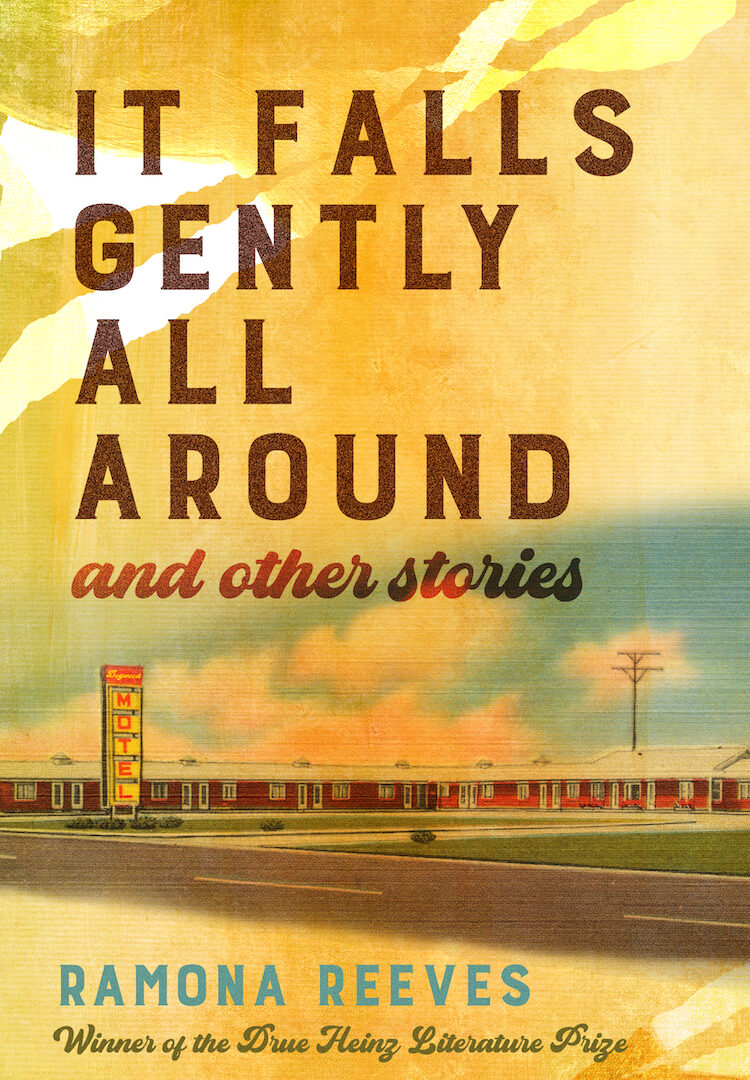Her Beautiful City: An Interview with Ramona Reeves
Karin Cecile Davidson

The characters of Ramona Reeves’s debut story collection, It Falls Gently All Around, winner of the Drue Heinz Literature Prize (University of Pittsburgh, 2022), lead us through the oak-lined streets, the trailer courts and truck stops, the tunnels and rough-hewn coastline of Mobile, Alabama. Like a love letter to her hometown, Reeves introduces these linked stories in honest and direct strokes, through the humor and compassion and grand mistakes of her main characters Babbie and Donnie, and from the perspectives of Corinne and Fay and the other personalities who appear inside these pages. The stories move through time, not chronologically, but in a way that makes sense to the collection, calling up themes of class and race and chasing down dreams, no matter the distance. From the portrayal of place to the exploration of lives on all sides of town, no matter how discrete, Reeves reveals a landscape that is as distinctive and dimensional as her prose, one which allows the reader to linger and, by the last page, wish for more.
“The beauty of Mobile was not found in its midtown or downtown high-ceilinged homes with their historic nameplates, prim azaleas, and impressive oaks. The beauty swelled from the dirty bay, the muck of oyster beds and oil rigs, and the fume-scarred Bankhead Tunnel … The cracked and broken parts of the city, if taken as a whole, amounted to shapes, color, and light that made Babbie want to live. That was her beautiful city.” —Babbie from “Wheel of Fortune”
KARIN CECILE DAVIDSON: Tell us about Babbie and her city, of your relationship to Mobile, and how place in these stories means much more than location?
RAMONA REEVES: Thank you for that question and for interviewing me, Karin. And thank you to Newfound for publishing this interview. About Babbie and place—on the one hand, Babbie is an insider in the stories of It Falls Gently All Around. She’s lived her entire life in Mobile, and she’s made some poor choices, some stemming from a belief that she doesn’t deserve better. As a character, I think she sees the surface beauty of Mobile, but it’s tainted and complicated for her because she’s experienced the underside of that beauty. In that sense, she’s also an outsider because she’s not permitted into the grand places of Mobile except as hired help (in “Queen of Frogs”) or as a potential nanny (in “Aphrodite Reclining”). So Babbie’s perspective on Mobile is informed by the way she feels about herself, the restrictions others have put on her, and the choices she’s made. Dorothy Allison wrote a great essay that’s included in The Writers Notebook, a book of essays published by Tin House. In the essay, Allison talks about place being informed by characters and their desire, emotions, and context. That’s what I tried to do in this collection, to build a sense of place through character perspectives. Because I’m a native of Mobile, I also wanted defamiliarize the city and bring fresh news to it through characters and objects that perhaps defy some stereotypes people may have about the Gulf Coast. I also use trees a lot in the book as a marker for class. Trees are a big part of the visual terrain in Mobile, but I hope they telegraph a lot more. I wanted them to connect to themes in the book.
DAVIDSON: That Dorothy Allison craft essay is truly amazing, I completely agree, and I think you’ve succeeded in creating that kind of informed place in your collection, partly in how you’ve established connections among the characters. To me, this recalls something Jennifer Egan once said. In her 2011 interview with the Minneapolis Star-Tribune, Jennifer Egan reflected on the characters of A Visit from the Goon Squad (which she also referred to elsewhere as “linked stories”) and how they were related: “At first, the characters were ‘little islands far apart—I didn’t see the land mass that connected them till later.’” Did you feel the same about your collection’s characters at any point? Which character was most difficult to write? And who came straight to you, telling you everything you needed to know? And did the overlapping relationships occur naturally over time in the drafting, or did you sometimes have to force these folks into the same space?
REEVES: I began this collection as part of a class I was taking. We were studying several interconnected story collections such as Olive Kitteridge, Ms. Hempel Chronicles, Mary and O’Neil and others. I wrote three or four stories while taking the class, so I always knew there would be connections, recurring characters, etc., between the stories.  When I went back to finish writing all the stories, I think my experience was similar to Egan’s deft description. There were certain stories I knew would be part of the book and others that came as a surprise. When Fay, for example, showed up in the story “Anniversary,” I felt drawn to write an entire story in her POV, but it wasn’t until I wrote “Anniversary” that I knew that. She was one of the easiest characters to write, as least initially. I found Rowan and Claire the most difficult to write. Their privilege allows them to look away from situations and ignore many social issues, but in their stories I tried to hold their feet to the fire, so to speak. And yes, I sometimes needed to create situations for the necessary interactions between characters. Parties and group scenes created opportunities to further develop characters, and in some cases, forced them to confront problems they’d been avoiding. But there’s also a lot to be said for placing two characters in tight quarters and seeing what happens. I’m thinking of Babbie and her ex-husband in the bathroom stall in “Last Call.”
When I went back to finish writing all the stories, I think my experience was similar to Egan’s deft description. There were certain stories I knew would be part of the book and others that came as a surprise. When Fay, for example, showed up in the story “Anniversary,” I felt drawn to write an entire story in her POV, but it wasn’t until I wrote “Anniversary” that I knew that. She was one of the easiest characters to write, as least initially. I found Rowan and Claire the most difficult to write. Their privilege allows them to look away from situations and ignore many social issues, but in their stories I tried to hold their feet to the fire, so to speak. And yes, I sometimes needed to create situations for the necessary interactions between characters. Parties and group scenes created opportunities to further develop characters, and in some cases, forced them to confront problems they’d been avoiding. But there’s also a lot to be said for placing two characters in tight quarters and seeing what happens. I’m thinking of Babbie and her ex-husband in the bathroom stall in “Last Call.”
“Some people had to make do with pressing their noses against the pretty parts of life.” —Babbie from “Last Call”
“… the road between maybe and certain always seemed under construction in his mind.” —Donnie from “The Balanced Side”
DAVIDSON: In exploring the lives of your characters, you find language that not only tells the stories but is specific to and works to develop each character. The way you string together words and thoughts, with sensory details dashed with mild and sometimes outright humorous tones, to create an almost wild irreverence and at the same time a deep respect for your fictional world is phenomenal. How did your style of writing develop? Has it been present since the beginning, or did you find your way to this distinctive style over time?
REEVES: That’s a fantastic question, and you’re the first to ask it. Years ago, I had the idea that writers were supposed to know early on what their style was. Maybe some do, but that was not the case for me. I spent years writing stories in a range of styles until I finally found my own through practice. Writing is its own teacher, which basically means that I had to work at it to find my voice and style, and I think I’ll need to keep working at it. It doesn’t feel like something that’s completely settled, but rather, something that continues to grow and develop. And thank you so much for saying my style is distinctive. That’s nice to hear.
“Some mornings … he sat … and listened as the birds began to wake. In those moments, he heard his father urging him to fly.” —Donnie from “The Balanced Side”
“Driving over the water gave her a sense of flying.” —Fay from “The Right Side of the Dash”
DAVIDSON: There are motifs of falling and flying throughout the collection—falling into trouble, falling in love, falling out of one relationship and flying into another, feeling called to fly, and having the freedom to fly. Falling rain, flying debris, falling bowling balls, flying down the highway. I heard you say once that “Chicken Little” was a favorite childhood story, the refrain of which everyone knows as “the sky is falling!” Tell us about how falling and flying relate to the stories of It Falls Gently All Around and perhaps to other writing you’ve done.
REEVES: I’m so glad you picked up on those images in the book. I don’t know, but I think stumbling or falling in life and then getting back up is the nature of being human and that because of it, people long for and look forward to uplifting moments. I’m talking about those perfect moments that may last only seconds but can inspire us to continue marching forward. This feels true for Donnie and Babbie, the two main characters, and truthfully, for all the characters in the collection. They fall, recover, and try to soar. Sometimes, however, if they soar too high, too soon, there’s an Icarus consequence. I’m not sure what it says about me that I loved “Chicken Little” so much as kid. Maybe I loved that she’s a Captain Happen in the story—that’s a Charles Baxter term. She definitely stirs up the barnyard and makes the story happen. Ha!
“He liked Duran Duran. She preferred Bon Jovi and Prince.” —Babbie from “It Falls Gently All Around”
DAVIDSON: Mostly alluded to, but sometimes mentioned, are the songs your characters dance to, as in “Sighting Dolphins” when the Knockers softball team celebrates their tenth anniversary, and the music they listen to inside eighteen-wheeler cabs driving west on I-10 or under the pines of the Bay Oak Trailer Park, “a heavy guitar riff, crushing the quiet of the early afternoon.” From Southern rock to disco to gospel, what would your playlist for It Falls Gently All Around sound like?
REEVES: I’ve never shared them, but I do have playlists for both Babbie and Donnie. The playlists helped me get to know them better. Donnie’s playlist is heavy on Southern rock and country. Babbie’s picks include many women artists such as Dolly, Adele, Aretha, and Bonnie Raitt. I think if I created a playlist for the book as a whole, I’d include Emmylou Harris, Jason Isbell, Alabama Shakes, ZZ Top, Mobile’s Excelsior Band, Joy Oladokun, Tanya Tucker, Marcia Ball, and some Lena Horne. I’m thinking about Horne’s “Stormy Weather.” And Babbie is onto something, I think, with her Bonnie Raitt pick, so I would add Raitt as well.
“… what Corinne saw as truth: people destroyed what they could not understand.” —Corinne from “Aphrodite Reclining”
DAVIDSON: Thematically, these stories are linked in terms of place and class, with place defining and revealing class in diverse ways, specific to the viewpoint the story is told from. There are many moving parts, one connected to another, all working together beautifully. Babbie thinks of “the pine tree side of town” as her side of town, simpler and less refined than the neighborhoods rich in live oaks and magnolias. In contrast, Corinne considers her privilege as complicated by her love of a woman, understanding that “circles could provide … but also prevent,” exclusiveness weighted against inclusion. What was it like to explore and negotiate all the connections and divisions? Did the characters guide you in ways that helped make sense of exclusion and inclusion?
REEVES: The characters often guided me. Corinne was a difficult one to write, though, until I realized her story hinges on her fall from grace, which happens because she is unable to live up to the expectations placed on her. Those expectations include marrying a man from her same or higher social stratum. She doesn’t marry a man, and her partner is from a class of people that some see as being beneath her. It was interesting exploring how Corinne is excluded. It became clear to me that her class standing is not only about money but also about conforming to a particular set of expectations and that this is one of the ways class operates to keep some people out and pressure others to remain in lockstep. Similarly, it was interesting to explore Donnie’s stories in which his brother and sister-in-law appear. Donnie doesn’t want to be like his affluent brother, and yet I think he wants his brother’s acceptance. Exploring those connections and divisions was exciting, but also sad at times. I could see characters almost connecting with others in the ways they most desired and then often falling short.
DAVIDSON: A trio of unrelated questions: (1) Which character would you most like to hang out with? (2) If these stories were made into a TV series, what actors could you see playing them? (3) Did any of the characters ever give you trouble, and if so, did you just lean into their direction or steer away from it?
REEVES: I’d most like to hang out with Deirdre or Fay. I honestly have no idea about who I would cast as that’s not my area of expertise, but Octavia Spencer came to mind for Deirdre, and Sally Field for Fay. Ha! Maybe Adam Driver for Donnie and an unknown for Babbie? But regardless, I hope people will read the stories and imagine their own casting! And yes, some of the characters did give me trouble, namely Rowan, Claire, and occasionally Donnie, but yes, I leaned into those challenges by continuing to write their stories. I also sometimes let those stories sit for a few weeks while I worked on something else. Doing that often helped me gain more clarity about a problem I was trying to work out in a story.
DAVIDSON: What directions do you see yourself taking in the future, with literary influences and aspirations in mind? Story collection, novel? New landscapes or maybe others familiar to you that we just don’t know about yet?
REEVES: I’ve been working on a novel for a while. It contains two time periods. One starts in Texas and ends up in Georgia, and the other starts in rural Alabama and ends up in New York City. The novel works with some of the same themes but adds new ones around truth/falsehood and independence/dependence.
Ramona Reeves lives with her wife in Texas. In addition to winning the 2022 Drue Heinz Prize, her work has appeared in The Southampton Review, Bayou Magazine, Texas Highways, Pembroke, Jabberwock Review, and others.
Karin Cecile Davidson is the author of the novel Sybelia Drive and the story collection The Geography of First Kisses, winner of the Acacia Fiction Prize. Originally from New Orleans, she writes stories set mostly in the Gulf Coast region.

